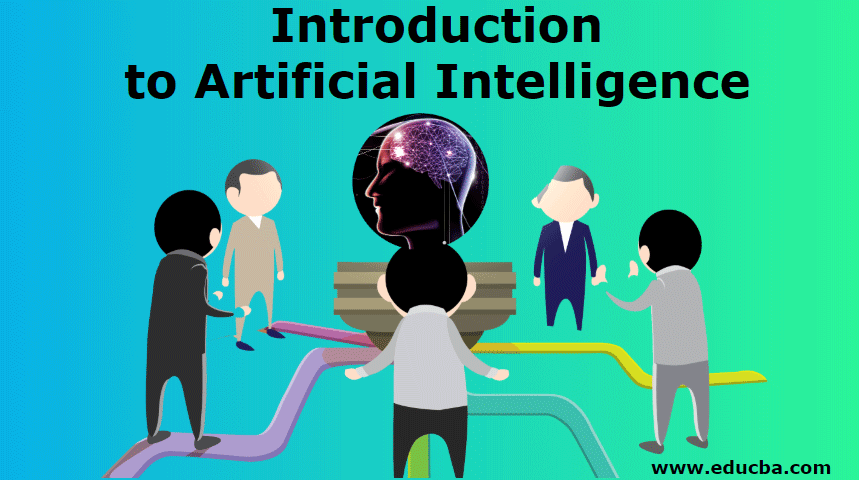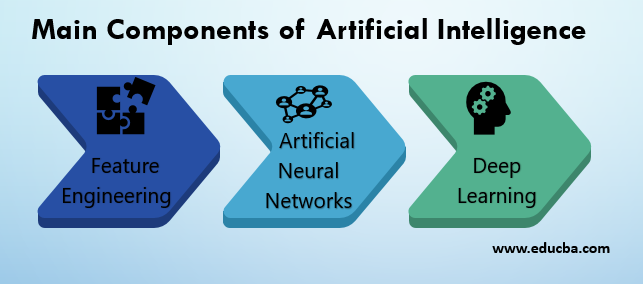Updated May 15, 2023

Introduction to Artificial Intelligence
The following article provides an outline for Introduction to Artificial Intelligence. Artificial Intelligence is the ability to design intelligent machines or to develop self-learning software applications that imitate the traits of the human mind like reasoning, problem-solving, planning, optimal decision-making, sensory perceptions, etc. The capacity of artificial intelligent approaches to outperform human actions in knowledge discovery gained the attention of business and research communities worldwide, and this field of study witnessed rapid progress in the past two decades.
Main Components and Characteristics of AI
Given below are the components or frameworks that majorly contribute towards the implementation of various intelligent systems as follows:
1. Feature Engineering
The process of identifying a minimal set of informative features or attributes from the provided dataset is called feature extraction. The performance of machine learning processes can be improved by correctly choosing a meaningful set of features.
The efficient feature extraction process ensures:
- Reduction of the degree of disorder, called entropy, while classifying datasets based on selected features. In other words, this optimal set of features maximizes Information gain.
- Zero correlation among the features, thereby achieving independence and minimality of the feature set. People achieve this objective using techniques like Principal Component Analysis (PCA), the Gram-Schmidt orthogonalization process, etc.
2. Artificial Neural Networks
A Neural Network comprises weighted interconnections between the set of computing nodes at consecutive layers. The optimal weights of connections are deduced in the learning phase by adjusting them per the common weight-sharing strategy and the feedback received from the implemented backward-propagation algorithm. Technically, each node calculates the weighted sum of values propagated to its input. Activation functions regulate the criteria for computed values to feed forward to the next layer. After a series of epochs, constituting feed-forward and back-propagation stages, weights and other network parameters converge to optimal values ending up with the most appropriate model.
The most commonly used Artificial Neural Networks are:
- Convolutional Neural Networks (CNN) convolves the received input with the learned spatial filters/patterns to identify features at the convolution layer. These signals are feed-forwarded to the next layers fully connected for recognition tasks.
- The robustness of convolution to translational variations effectively fuel the recognition or labeling of features, and researchers extensively use this approach in image recognition applications.
- Recurrent Neural Networks (RNN) use Long Term Short Memory (LTSM) to estimate unknown values from the given series of past data.
3. Deep Learning
Deep learning architecture has more hidden layers between the input and output layers when compared to that artificial neural networks. This architectural change facilitates the deep learning framework to perform automatic feature extraction and classification learning. These models employ supervised learning to train with well-labeled datasets. Despite the inherent complexity of the architecture with numerous hidden layers, the learning time of the model can be drastically reduced with the usage of high-performance parallel-computing GPUs.
Applications of AI
So now we are discussing the theories and methods related to AI revolutionizing all fields, including Retail, Finance, Space research, Healthcare, Consumer Electronics, Automobiles, etc.
The details for a few applications are as below:
1. Ethical Gene Editing
The notion of personalized medical care to treat diseases or disorders caused due to gene mutations is achieved by precisely understanding the patient’s genetic blueprint. The analysis to identify the order of nucleotides is called Genome Sequencing. Insights obtained from genome sequencing enable the identification of susceptible mutations, allowing for the prescription of a sufferer-specific line of treatment.
2. Intelligent Disaster Response System
Modern rescue systems use AI-powered drones, robots, and sensors to quickly gather precise information regarding the extent of damage, the exact location of trapped victims, and topographical details of the landscape during crisis times. Intelligent systems assist rescue workers in identifying the nearest and safest assemble points while evacuating people from disaster-hit areas. AI-equipped disaster management modules effectively stimulate mock disaster drills to identify potentially vulnerable locations, plan preventive actions, to monitor and govern resource allocation seamlessly.
3. Recommendation Systems
The best recommendation systems identify or predict users’ preferences for items based on items’ profiles and inferences about users’ behavior. The utility matrix captures users’ preferences towards various items, representing their willingness through user-item pairs.
The two ways of discovering users’ responses to items are:
- Content-based recommendations understand users’ interests based on the ratings/feedback provided for a few things and suggest similar items.
- Collaborative filtering focuses on identifying similar users and recommending items preferred by similar users.
Mathematically, the represented utility matrix is sparse. The recommendation algorithm aims to deduce unknown/missed entries from the few known values using clustering algorithms and matrix factorization methods like singular value decomposition (SVD).
Advantages of Artificial Intelligence
Given below are the advantages of artificial intelligence:
- Minimal Human Intervention: AI-powered systems are the best-fit solutions in environments where human life is more likely to be at risk. Examples of such scenarios are space exploration, defense operations like bomb defusing, workplaces characterized by intense heat, Mineral mining, etc.
- Faster and Accurate: The performance of well-trained AI-enabled applications drastically reduces the chance for human errors to creep in. These AI versions proved faster at computationally expensive tasks, especially in scientific research and time-consuming tasks. Proper implementation of AI technology can drive automation in routine, trivial, and repetitive tasks, leading to improved operational efficiencies.
Challenges
Given below are the challenges mentioned:
1. Need for Massive Data Corpus
In general, intelligent systems undergo a training and validation process where they learn an optimized model by utilizing a substantial amount of data before deploying them as real-world solutions. The availability of huge data volumes and the ability to handle them are the major limitations for conventional systems and software applications to evolve as AI-enabled editions. The need for sophisticated modeling techniques that can estimate the model parameters with high precision using limited data samples is imminent.
2. Multimodal Interactions
By leveraging the ability to interpret and process multiple data modes simultaneously, it is possible to improve the efficiency and precision of perception-based recognition applications encompassing computer-vision methods. This enables the recognition paradigm to ideally emulate human intelligence that works with various senses like touch, vision, hearing, etc.
3. Beyond Human Control
With the exceptional capability of AI technology to understand and learn vast libraries of information faster, there are few threatening instances where an AI framework gained an emotional quotient and surpassed the extremities of human logical thinking. In such unregulated cases, the unusual behavior of AI systems would lead to irreparable catastrophe.
Recommended Articles
This has been a guide to Introduction to Artificial Intelligence. Here we have discussed AI’s characteristics, challenges, applications, and advantages. You may also look at the following articles to learn more –


